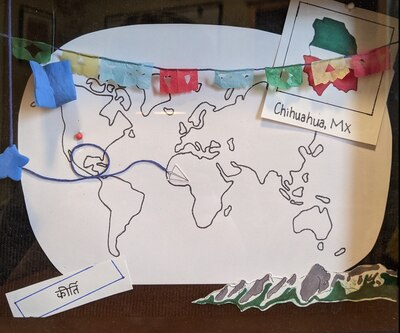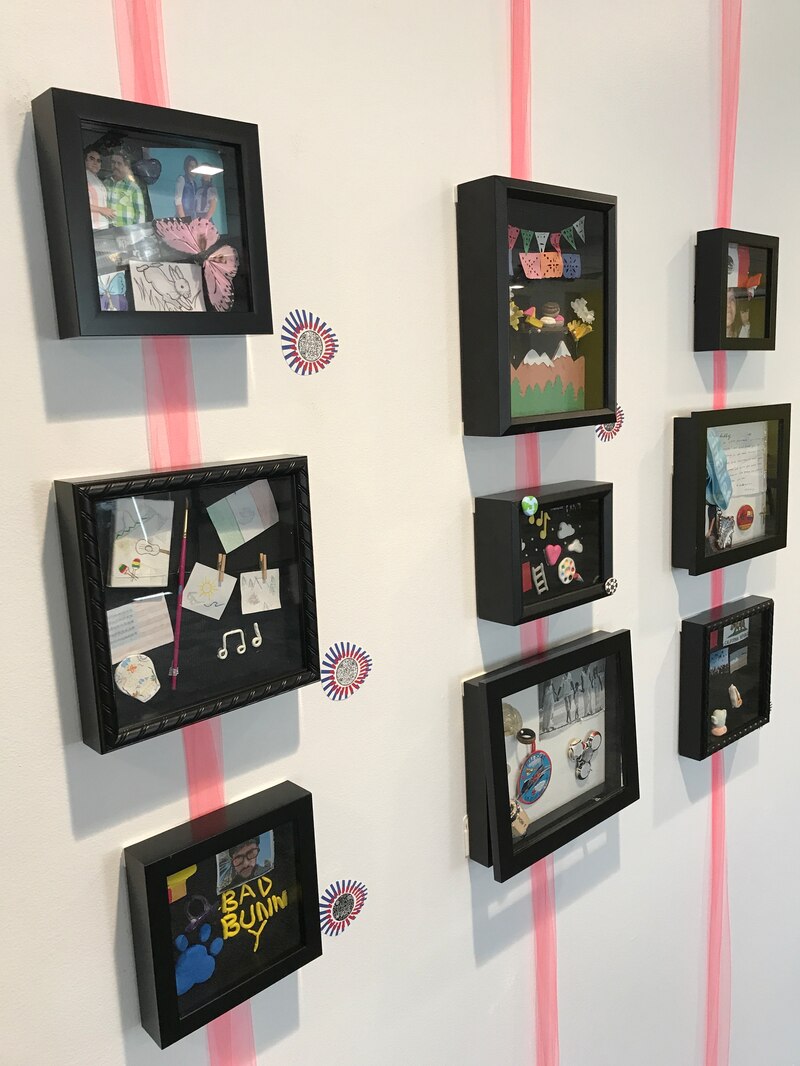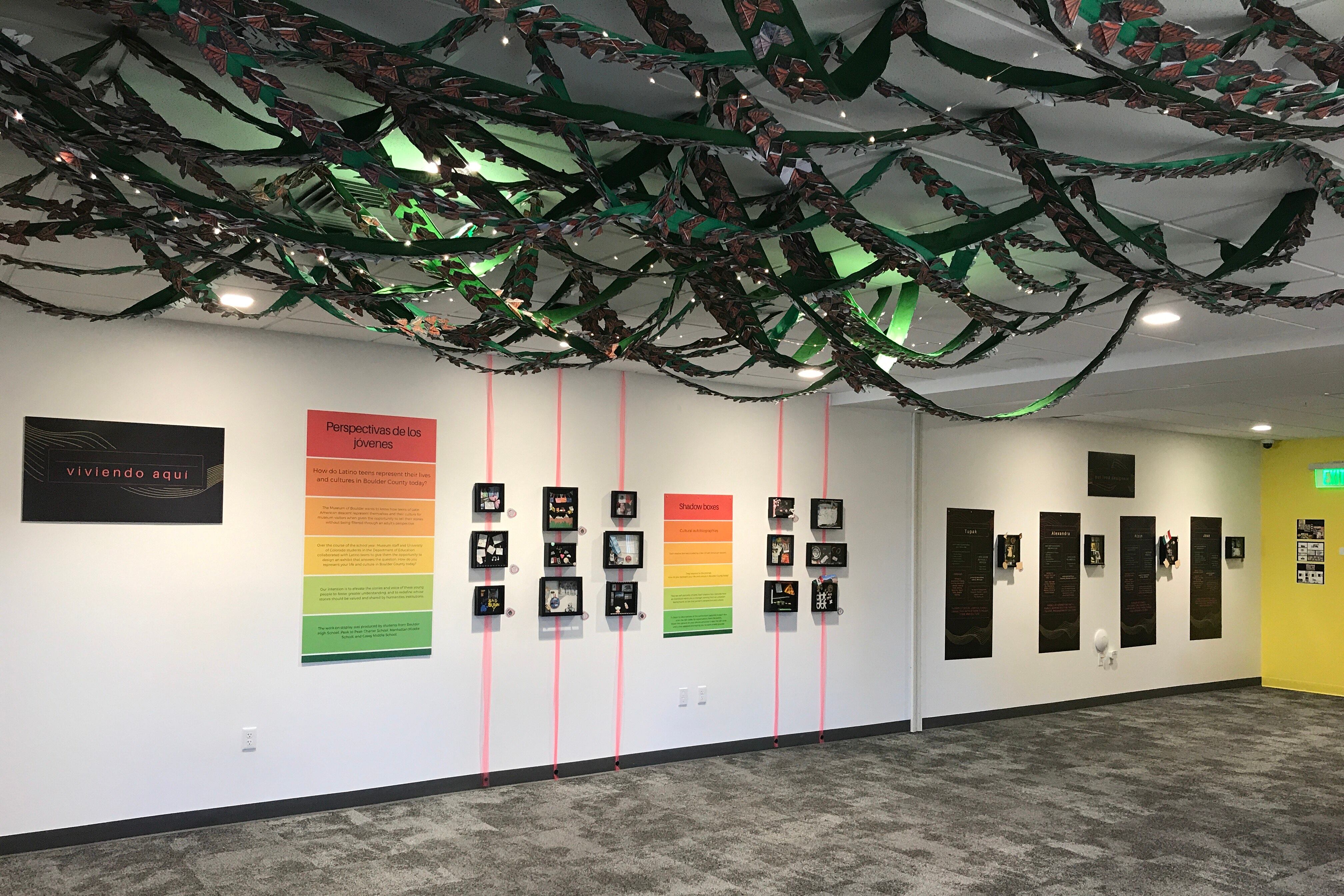Inside one shadow box, a map Isa Brady drew shows the way to both her past and her future.
It marks the place she grew up, Boulder, and highlights Chihuahua, Mexico, where her mother’s family comes from and where many of her family members still live. Then there’s a loop, with an arrow representing Isa’s hope to one day travel and see more of the world. Across the map, she draped papel picado, a colorful cut-out flag banner common in Mexican celebrations.

Isa is one of more than a hundred students from various schools in Boulder who are participating in a project to showcase their Latino culture in Boulder. The exhibit, “Viviendo Aquí - Perspectivas de los jóvenes,” or “Living Here, the Youths’ Perspective,” which opened Friday, is all about student storytelling. Some 15 students have given their shadow boxes to the Museum of Boulder to display.
Isa would like her box to help people see her identity as a 14-year-old Latina living in Boulder.
“I wanted to give off the sense that I still identify as Latina, but it doesn’t confine me to stereotypes,” Isa said. “At the same time, I also embrace a lot of the culture that is sometimes stereotyped especially in the community that doesn’t have a lot of Latinos.”
In other boxes, students have displayed photos, images of the Virgin of Guadalupe, and chile-flavored candy.
The museum has been working on a longer project with the Boulder County History Project to highlight Latino culture in Boulder, including documenting family histories. That exhibit is expected to be ready early next year.
“It’s so important, in my mind, for the exhibit that is going to attempt to showcase the breadth of Latino experiences past and present, to really have a strong youth perspective,” said Emily Zinn, the director of education for the Museum of Boulder.
Census data shows about 10% of Boulder residents identity as Hispanic. In the Boulder Valley School District, about 19% of students are identified as Hispanic.
The students came up with the idea for the shadow boxes. The museum annually works with a group of teenagers in a Teen Corps program. This year, the group was asked to help co-design an exhibit that would help highlight Latino youth.
“I have been interested for such a long time in how one could design an exhibit that allows individuals, your everyday visitor, to bring artifacts and ideas and stories of their own that they added to their exhibit in a living manner, without a curator needing to filter their story or disrupt it or get it wrong,” Zinn said.
The teenagers surprised her by coming up with such a simple idea that allows for that: shadow boxes.
Earlier this year, while students across Boulder were learning remotely, the museum gathered the boxes and other materials such as string, wire, and pins.
At Peak to Peak Charter School, one of approximately six schools that participated, teacher Joseph Barbour then spent hours separating materials into individual kits and delivering them to each student’s home.
More than 100 students across Boulder worked on the boxes and then decided if they wanted to share their work. The museum was able to accept every entry that was submitted.

“This really quite simple concept has solved that problem in an interesting way,” Zinn said about being able to find a way to allow teens to participate without needing a curator. “This has no adult hand in it.”
Zinn said the museum is also planning to experiment, based on the students’ ideas, with leaving an empty shadow box in the museum to see if any visitors are interested in taking it home and bringing it back to contribute to this exhibition or the larger one next year.
Barbour said his students who worked on the project, those in the school’s Spanish for Heritage Speakers course, enjoyed it.
For some, he said, it was a stress-free project to work on while other classes were becoming more busy as the quarter came to a close, but for others, it was a fun exploration of their identity and how they would want that identity to be expressed to others.
“To see a little bit more of the actual community represented in the museum and see it’s not just one type of artist or material that should be included is powerful,” he said.
Zinn said it was important to students planning and designing the exhibit that it can represent Latino youth experiences as a whole while showing that all experiences vary and not asking one person to carry all of the responsibility of representing everything at once.
“That nuance that individuals bring, that breadth of perspectives, has been a real specific desire of the young people we’ve worked with,” Zinn said.
Isa also wants the project to let people know that while there is a unity among Latinos, no one is quite the same.
“I’m not going to have the same experience as my cousin or even my mom,” Isa said.
Jose Rogelio Manriquez-Hernandez, a senior at University of Colorado Boulder studying history and education, also helped lead the project with the museum.
He said that just talking to students about the project and brainstorming ideas was educational and meaningful for him and the teenagers.
“Having this project to connect with students has been so inspiring,” Manriquez-Hernandez said. “It made me so happy to have a community I can relate to.”
And connection is another main theme students have told adults involved in the project that they want people to take from the exhibit.
“Just the feeling that they’re not alone,” Manriquez-Hernandez said. “I don’t see much representation of Latinx culture for people here in Boulder. But they’re not alone out there. There are others like them.”
Isa said the way she designed her box also reflected on the pandemic and the past year’s racial justice movement and includes words of hope for people who are having a rough time.
“A better understanding of race is something people need, especially right now, I think,” Isa said. “A lot of people are feeling alone and need this.”








